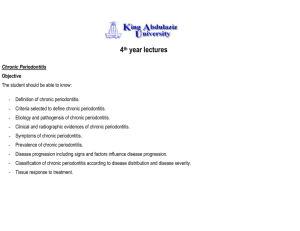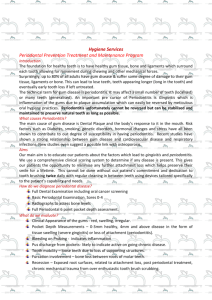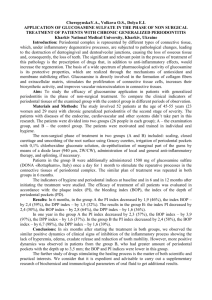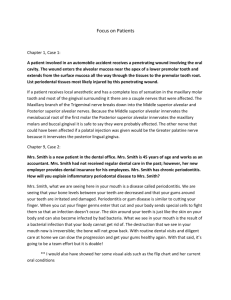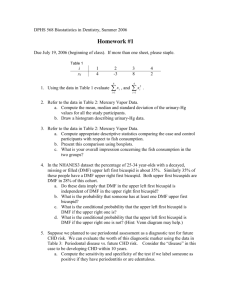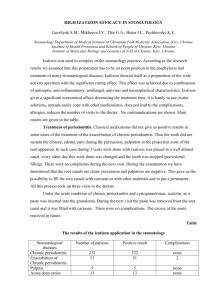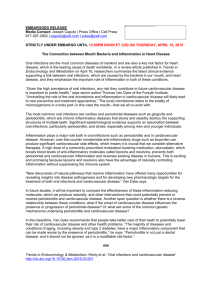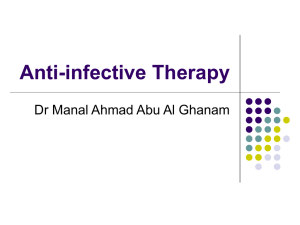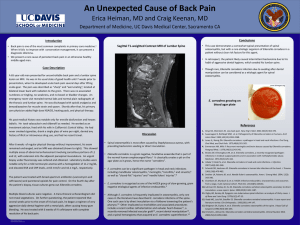Antibacterial Effects of Enoxolone on Periodontopathogenic and
advertisement
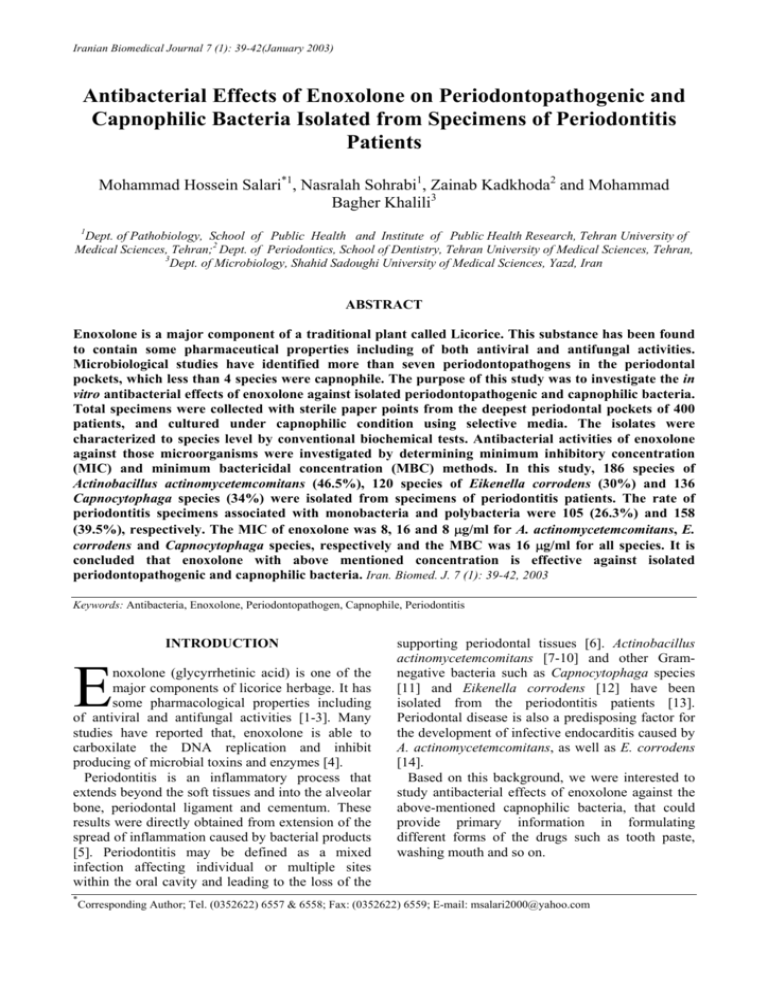
Iranian Biomedical Journal 7 (1): 39-42(January 2003) Antibacterial Effects of Enoxolone on Periodontopathogenic and Capnophilic Bacteria Isolated from Specimens of Periodontitis Patients Mohammad Hossein Salari*1, Nasralah Sohrabi1, Zainab Kadkhoda2 and Mohammad Bagher Khalili3 1 Dept. of Pathobiology, School of Public Health and Institute of Public Health Research, Tehran University of Medical Sciences, Tehran;2 Dept. of Periodontics, School of Dentistry, Tehran University of Medical Sciences, Tehran, 3 Dept. of Microbiology, Shahid Sadoughi University of Medical Sciences, Yazd, Iran ABSTRACT Enoxolone is a major component of a traditional plant called Licorice. This substance has been found to contain some pharmaceutical properties including of both antiviral and antifungal activities. Microbiological studies have identified more than seven periodontopathogens in the periodontal pockets, which less than 4 species were capnophile. The purpose of this study was to investigate the in vitro antibacterial effects of enoxolone against isolated periodontopathogenic and capnophilic bacteria. Total specimens were collected with sterile paper points from the deepest periodontal pockets of 400 patients, and cultured under capnophilic condition using selective media. The isolates were characterized to species level by conventional biochemical tests. Antibacterial activities of enoxolone against those microorganisms were investigated by determining minimum inhibitory concentration (MIC) and minimum bactericidal concentration (MBC) methods. In this study, 186 species of Actinobacillus actinomycetemcomitans (46.5%), 120 species of Eikenella corrodens (30%) and 136 Capnocytophaga species (34%) were isolated from specimens of periodontitis patients. The rate of periodontitis specimens associated with monobacteria and polybacteria were 105 (26.3%) and 158 (39.5%), respectively. The MIC of enoxolone was 8, 16 and 8 µg/ml for A. actinomycetemcomitans, E. corrodens and Capnocytophaga species, respectively and the MBC was 16 µg/ml for all species. It is concluded that enoxolone with above mentioned concentration is effective against isolated periodontopathogenic and capnophilic bacteria. Iran. Biomed. J. 7 (1): 39-42, 2003 Keywords: Antibacteria, Enoxolone, Periodontopathogen, Capnophile, Periodontitis INTRODUCTION E noxolone (glycyrrhetinic acid) is one of the major components of licorice herbage. It has some pharmacological properties including of antiviral and antifungal activities [1-3]. Many studies have reported that, enoxolone is able to carboxilate the DNA replication and inhibit producing of microbial toxins and enzymes [4]. Periodontitis is an inflammatory process that extends beyond the soft tissues and into the alveolar bone, periodontal ligament and cementum. These results were directly obtained from extension of the spread of inflammation caused by bacterial products [5]. Periodontitis may be defined as a mixed infection affecting individual or multiple sites within the oral cavity and leading to the loss of the * supporting periodontal tissues [6]. Actinobacillus actinomycetemcomitans [7-10] and other Gramnegative bacteria such as Capnocytophaga species [11] and Eikenella corrodens [12] have been isolated from the periodontitis patients [13]. Periodontal disease is also a predisposing factor for the development of infective endocarditis caused by A. actinomycetemcomitans, as well as E. corrodens [14]. Based on this background, we were interested to study antibacterial effects of enoxolone against the above-mentioned capnophilic bacteria, that could provide primary information in formulating different forms of the drugs such as tooth paste, washing mouth and so on. Corresponding Author; Tel. (0352622) 6557 & 6558; Fax: (0352622) 6559; E-mail: msalari2000@yahoo.com Iranian Biomedical Journal 7 (1): x-x (January 2003) Table 1. The periodontitis patients on the basis of sex, age and isolated periodontopathogenic and capnophilic bacteria. Sex Bacteria Male n % A. Actinomycetemcomitans E. corrodens Capnocytophaga (spp.) 68 49 74 17.0 12.2 18.5 Age Female n % 118 71 62 29.5 17.7 15.5 <20 n % 20-29 n % n 8 6 7 49 42 38 89 47 63 2.0 1.5 1.7 12.2 10.5 9.5 30-39 % 22.2 11.7 15.7 ≥40 Total % n % n 40 25 28 10 6.3 7.0 186 120 136 46.5 30.0 34.0 turbidity was subcultured on TSBV and TSBP media and incubated at 37°C under 5% CO2 for 2448 hours. The number of grown colonies on this subculture after incubation period was counted and compared to the number of CFU/ml in the original inoculum. The lowest concentration of enoxolone that allowed less than 0.1% of the original inoculum to survive, was said to be the minimum bactericidal concentration (MBC) [20]. MATERIALS AND METHODS From the deepest pockets of 400 patients who had been referred to the Department of Periodontology, School of Dentistry, Tehran University of Medical Sciences, microbial specimens were collected by sterile paper points (Antaeos, Munich, Germany) during September 1999-2000. The specimens were transferred into a transport fluid medium with 25% glucose [15] to the Bacteriology laboratory, School of Public Health, Tehran University of Medical Sciences. Then, the specimens were cultured on trypticase soy blood agar, that comprises bacitracin and vancomycin (TSBV) and also bacitracin and polymyxin (TSBP) media (Difco) and cultured media were incubated at 37°C under 5% CO2 for 24-48 hours. For identification of isolated bacteria, further investigations were made using biochemical tests including of oxidase, catalase, indole, nitrate to nitrite, fermentation of maltose, sucrose and lactose [16-20]. Investigation of antibacterial properties of enoxolone powder (Daru pakhsh, Tehran), against periodontopathogenic and capnophilic bacteria was made as follow: The purified enoxolone powder was dissolved in sterile Mueller Hilton broth (Difco) and filtered using 0.5 µm pore size filter paper (Millipore). Different concentrations of enoxolone were used to prepare a series of diluted tubes. For the broth dilution susceptibility test, a standard inoculum of the microorganism (organisms 1 × 06 ml, a 1:500 dilution of a suspension of turbidity equal to a McFarland standard 1.0) was added to an equal volume (often 1 ml) of each concentration of enoxolone and to a tube of the growth medium without enoxolone, which serves as a growth control. An uninoculated tube of medium was incubated to serve as a negative growth control. After sufficient incubation (18-24 hours), at 37°C under 5% CO2, the tubes were examined for turbidity, indicating growth of the microorganism. The lowest concentration of the enoxolone that inhibited growth of the organism, was designated the minimum inhibitory concentration (MIC). After the MIC has been determined, 0.1ml of inoculum from each of the tubes of broth without visible RESULTS AND DISCUSSION Antibacterial resistance is an important issue that has created a number of problems in treatment of infectious diseases. The existence of resistance necessitates the investigation about natural antibacterial substances. In this study, the frequency of isolated periodontopathogenic and capnophilic bacteria on the basis of sex and age of patients are shown in Table 1. The isolated bacteria were A. actinomycetemcomitans (46.5%), E. corrodens (30%) and Capnocytophaga species (34%). The rate of specimens associated with monobacteria and polybacteria were 105 (26.3%) and 158 (39.5%), respectively and bacterial growth was not observed in 137 specimens (34.3%) (Table 2). Table 2. The rate of specimens of periodontitis patients associated with monobacteria and polybacteria. Specimens ( n = 400) Number Percent Monobacteria (n = 105) A . actinomycetemcomitans E . corrodens Capnocytophaga (spp.) 71 19 15 17.7 4.7 3.7 A. actinomycetemcomitans E. corrodens 32 8.0 A. actinomycetemcomitans 52 13.0 E. corrodens Capnocytophaga (spp.) 38 9.5 A. actinomycetemcomitans E. corrodens Capnocytophaga (spp.) 31 7.7 Polybacteria (n = 153) Capnocytophaga (spp.) ٤٠ Salari et al. Table 3. The sensitivity of isolated periodontopathogenic and capnophilic bacteria to different concentrations of enoxolone. Enoxolone (µg/ml) 2 4 8 16 32 64 128 256 512 n 0 18 81 40 19 16 8 4 0 A. actinomycetemcomitans N = 186 MIC MBC % n % 0 0 0 (9.7) 0 0 (43.0) 51 (24.7) (21.5) 61 (32.7) (10.2) 29 (15.6) (8.6) 21 (11.3) (4.3) 14 (7.5) (2.1) 8 (4.3) 0 2 (1.07) E .corrodens n = 120 n 0 22 36 45 11 6 0 0 0 MIC % 0 (18.3) (30.0) (37.5) (9.1) (5.0) 0 0 0 A. actinomycetemcomitans and Capnocytophaga species were identified in the highest proportions in the patients. This was in accordance with other studies [21, 22], where A. actinomycetemcomitans and Capnocytophaga species were shown to be the most prevalent bacteria in periodontitis. A. actinomycetemcomitans is one of the most strongly active organisms associated with periodontitis and also seems to play a role in the pathogenesis [9]. Results from this evaluation confirm the complexity of the microbial composition associated with periodontitis. These results are in accordance with the studies by Socranky and Haffagee [23] and Mandell [24]. The MIC of enoxolone was 8, 16 and 8 µg/ml for A. actinomycetemcomitans, E. corrodens and Capnocytophaga species, respectively and the MBC was 16 µg/ml for all respectively and the MBC was 16 µg/ml for all species (Table 3). It has been shown that, enoxolone inhibits DNA replication by carboxylating and inhibits production of microbial toxins and enzymes [4]. It has synergistic effect if used together with mouth washing and gels for topical treatment of skin, oral and dental infections [5, 25]. Effectiveness of enoxolone in viral diseases like influenza, encephalitis and also Candida albican infection in vitro has been reported and remains to be studied in vivo [1-3]. Further studies to clarify the place of enoxolone in therapy of infectious disease are suggested. n 0 0 21 47 25 19 8 0 0 MBC % 0 0 (17.5) (39.1) (20.8) (15.8) (6.6) 0 0 n 0 26 53 47 8 2 0 0 0 Capnocytophaga (spp.) n = 136 MIC MBC % n % 0 0 0 (19.1) 0 0 (39.0) 36 (26.4) (34.5) 59 (43.3) (5.8) 19 (14.0) (1.4) 17 (12.5) 0 5 (3.6) 0 0 0 0 0 0 REFERENCES 1. Badam, L., Amagaya, S. and Pollard, B. (1997) In vitro activity of licorice and glycyrrhetinic acid on Japanese encephalitis virus. J. Community Dis. 29: 91-99. 2. Fuji, H.Y., Tian, J. and Luka, C. (1986) Effect of glycyrrhetinic acid on influenza virus and pathogenic bacteria. Bull. Chin. Mater. Med. 11: 238-241. 3. Guo, N., Takechi, M. and Uno, C. (1991) Protective effects of glycyrrhetinic acid in mice with systhemic Candida albicans infection and it’s mechanism. J. Pharm. Pharmacol. 12: 380 -383. 4. Chen, X.G. and Han, R. (1994) Effect of glycyrrhetinic acid on DNA repair synthesis. Acta Pharma. Sinica 29: 725-772. 5. Marsh, P. and Martin, M.V. (1999) Oral Microbiology. British library Cataloging in Publication Data, Oxford, UK. PP. 104-127. 6. Page, R.C. (1991) The role of inflammatory mediators in the pathogenesis of periodontal disease. J. Periodontal. Res. 26: 230-242. 7. Mueller, H.P., Eger, T., Lohinsky, D., Hoffmann, S. and Zoeller, L. (1997) A longitudinal study of Actinobacillus actinomycetemcomitans in army recruits. J. Periodontal. Res. 32: 69-78. 8. Muller, H.P. and Flores-de-Jacoby, L. (1985) The composition of the subgingival microflora of young adults suffering from juvenile periodontitis. J. Clin. Periodontal. 12: 113123. 9. Slots, J., Feik, D. and Rame, T.E. (1990) Actinobacillus actinomycetemcomitans and Bacte-roides intermedius in human periodontitis. J. Clin. Periodontol. 17: 659-662. 10. Tinoco, E.M., Beldi, M.I., Loureiro, C.A., Lana, M., Camedelli, F., Tinoco, M.N., Gjermo, P. and Preus, H.R. (1997) Localized juvenile periodontitis and Actinobacillus ACKNOWLEDGEMENTS Authors wish to thank Drs. K. Ghazi-Saeedi, R. Hafezi, A.A. Hanafi-Bojd, N. Iranparast and F. Falah for their kind assistance in this study. 41 Salari et al. 11. 12. 13. 14. 15. 16. 17. 18. 19. Mandel, R.L. (1987) A selective medium for Actinobacillus actinomycetemcomitans and incidence of organism. J. Periodontol. 52: 593600. 20. Baron, E.J. and finegold, S.M. (1990) Bailey and Scott,s diagnostic Microbiology. Library of Congress Cataloging-in-Publication Data., Mosby, USA. pp. 171-183 & 422-430. 21. Riggio, M.P., Macfarlane, T.W. and Mackenzie, D. (1996) Comparison of polymerase chain reaction and culture methods for detection of Actinobacillus actinomycetemcomitans and porphyromonas gingivalis in subgingival plaque samples. J. periodontol. Res. 31:496501. 22. Ciantar, M., Spratt, D.A., Newman, H.N. and Wilson, M. (2001) Capnocytophaga Granulosa and Capnocytophaga haemolytica: novel species in subgingival plaque. J. Clin. Periodontol. 28: 701-705. 23. Socranky, S.S. and Haffagee, A.D. (1992) The bacterial etiology of destructive periodontal disease: current concepts. J. periodontol. 63: 322-331. 24. Mandell, R.L. (1984) A longitudinal microbiological investigation of Actinobacillus actinomycetem-comitans and Eikenella corrodens in juvenile periodontitis. Infect. Immun. 45: 778-780. 25. Oueille, C. and Raynaud, F. (1982) Clinical evalutation of a 2% glycyrrhetinic acide cream in pediatric dermatology. Ann. Pediatr. 29: 599-601. actinomycetemcomitans in a Brazilian population. Eur. J. Oral Sci. 105: 9-14. Conrads, G., Mutters, R., Fischer, J., Brauner, A., Lutticken, R. and Lampert, F. (1996) PCR reaction and dot-blot hybridization to monitor the distribution of oral pathogens with in plaque sample of periodontally healthy individuals. J. Periodontol. 67: 994-1003. Soder, P.O., Jin, L.J. and Soder, B. (1993) DNA probe detection of periodontopathogens in advanced periodontitis. Scand. J. Dent. Res. 101: 363-370. Augthun, M. and Conrads, G. (1997) Microbial findings of deep peri-implant bone defects. Int. J. Oral Maxillofac. Implant. 12: 106-112. El Khizzi, N., Lasab, S.A. and Osoba, A.O. (1997) Hacek group endocarditis at the Riyabh Armed Forces Hospital. J. Infect. 34: 69-74. Syed, S.A. and Loesche, W.J. (1972) survival of human dental plaque flora in various transport media. J. Appl. Microbiol. 24: 638-644. Slots, J. (1982) Selective medium for isolation of Actinobacillus actinomycetemcomitans. J. Clin. Microbiol. 15: 606-609. Mutters, R., Piechulla, K. and Mannheim, W. (1984) Phenotypic differentiation of pasteurella and the Actinobacillus group. Eur. J. Clin. Microbiol. 3: 225 -229. Yammoto, T., Kajiura, S., Hirai, Y. and Watanabe, T. (1994) Capnocytophaga haemolytica spp. and Capnocytophaga granulosa spp. from human dental plaque. Int. J. Syst. Bacteriol. 44: 324-329. ٤٢
